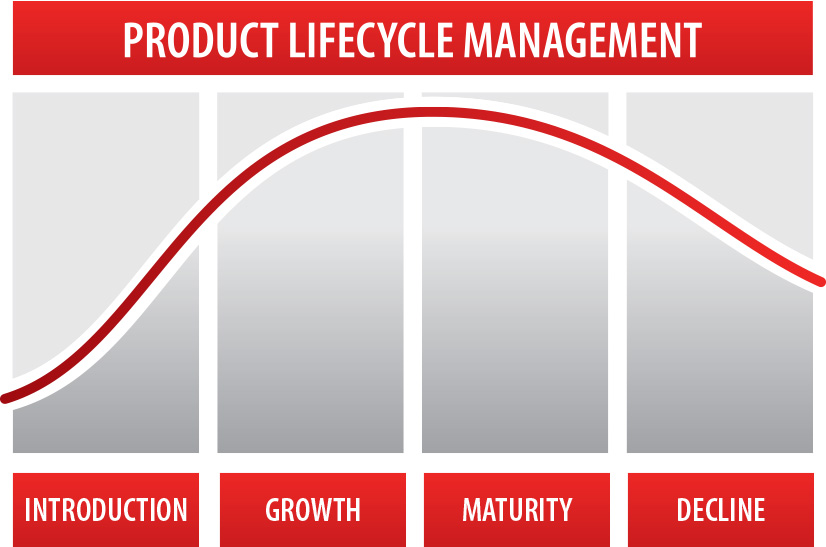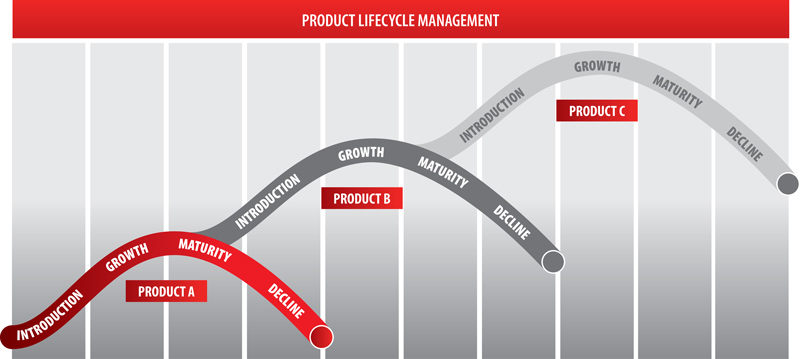Cradle to Grave – True Benefits of Product Life Cycle Management
I’ve found myself lately doing an awful lot more work in the area of Product Lifecycle Management. I can’t really explain why it is getting more attention now than in the past as product lifecycle management has been a core part of product management for a long time so I’m going to put it down to the good auld reliable, everything we seem to blame things on these days – ‘The Recession’, ‘The Celtic Tiger Burst’, ‘The Downturn’ – whatever you like you call it.
A few years back, what was an extra €20k on prototyping costs or the wage bill of sales staff who were paid salaries and so on, when the new product took 12 months longer than anticipated to get to market? Today It Matters!! Today it’s the difference between being able to pay salaries or having to cut staffing levels or more worryingly having to close your doors. Companies nowadays, especially SME’s, many of which we work with here in IMS, have realised that correctly understanding their products or services life cycle, whether it’s new or existing, can have huge and long term cost benefits.
Here are just some of the benefits companies can enjoy with strategic and well thought out Product Life Cycle Management:
1. Reduced time to market
2. Reduced market entry costs
3. More efficient and profitable distribution channels
4. Higher return on investment from promotional campaigns
5. Extend the lifetime of your product by adapting your approach as it moves through the lifecycle
6. Orderly and profitable end of life product management
There are essentially 4 stages in the modern Product Life Cycle namely – Introduction, Growth, Maturity, Decline.

The Introduction Stage of the Product Lifecycle
This introduction stage relates to new products being launched on the market for the first time. The most important element here is to correctly define your target audience and determine how you are going to effectively reach them with your message and product. You essentially want to connect with the ‘early adopters’ to generate early market penetration. These early adopters are most likely to provide you with considerable and constructive feedback that will be invaluable going forward with your product.
At product introduction stage it is typical for sales and marketing costs to be high with turnover low. In many cases products are not profitable at a market introduction stage due to low market adoption.
You may find distributors or third party re-sellers are reluctant to take on your new product as it is yet to be a proven seller so the strategic targeting of key distributors or even a direct sales approach may work best at this stage. Your pricing strategy also needs to be carefully considered.
The pricing strategy might be that of Price Skimming where the highest amount possible is charged initially and then slowly reduced. Or the price strategy might be Penetration Pricing, where the lowest possible price is charged and then gradually increased. Both are strategies that focus on increasing market share quickly.
In summary, the main objective of the product introduction stage is to achieve early market adoption while showing and demonstrating a positive trend of sales and distribution growth which will lead to profitability.
The Growth Stage of the Product Lifecycle
You’ll find during this stage that while you’re steadily growing sales your competitors are now tagging along for the ride. Your product has been accepted by your target market and cash flow is positive. You’re selling well so your manufacturing costs are lessened – you’re enjoying economies of scale and you’re starting to make profits.
The strategy during this growth stage might include investing in advertising to promote brand awareness to a wider target audience (“Early Majority”). Ideally you’re looking to penetrate the market – taking your competitors customers, encouraging non users to start buying your product and maybe convincing current customers to buy more of your product.
Distribution growth is normally a key driver of sales growth at this stage so you may wish to broaden the number and type of channels used (eg a combination of traditional and online sales). You will also need to continue educating and keep your product at the forefront of your target audiences mind so this means continued promotional spending.
The growth stage is also the ideal phase in which to make improvements to your product. If you are selling software for example maybe you could add on new features or improve the interface to give the product a fresh look, all the while offering current customers ‘added value’.
The Maturity Stage of the Product Lifecycle
During the maturity stage sales will typically be flat, and the profit margins of your products will begin to decline. This is typically caused by a number of factors including market saturation or the displacement of your product with other alternative solutions or technologies. In this stage the nature of competition is often very price driven.
Mature markets can often present opportunities for companies however if an innovative outlook is taken. Do other markets exist where your current product or technology can find growth (eg international markets)? Fiat Tractors is an outstanding example of a company that changed their sales channels and market and even their brand in order to remain competitive back in the 1960’s.
When the western world wanted new hi-tech tractors Fiat found themselves with a stock of traditional basic models that their target market no longer wanted. Having carried out much research the company began selling these traditional tractors in countries like Turkey at a price point suitable to the market. Seeing instant success Fiat secured a licensing agreement with Turkish company Tümosan to manufacture the tractors in the home country and even changed the brand name to Turk Fiat to align themselves more closely with the country and its culture.
The maturity stage is also the time to start planning and researching for a next generation product or technology – don’t wait until your product enters the decline stage. Invest in market research therefore.


The Decline Stage of the Product Lifecycle
During this decline stage you will most certainly notice a decline in sales. Your market is now either saturated and/or overrun by competitors. You will see a decline in profits and cash flow will become somewhat weaker.
So what are the potential strategies during the decline stage of the product lifecycle?
You could choose to harvest cash from your ‘cash cow’ product and invest these funds in a more promising brand. If you have done your research in the maturity stage for a next generation product or new product introduction you will be able to invest more time and resources into this.
According to Pareto’s Law for product lines typically 80% of profits or sales come from 20% of products. What he’s really saying here is that companies continuously add products to their product line and fund each addition, focusing on the entire portfolio. Why not look at product line rationalization and focus resources on growing your ‘cash cows’ and products that are yielding that 80% of profits.
All products in the product lifecycle should have an exit strategy. How you remove the product from market in the most professional and manageable manner is vitally important to the company’s reputation. An exit strategy would normally coincide with the introduction of a next generation product or new product introduction. It is vital that advanced communication to channel partners, customers, in fact all stakeholders is clear, concise and understandable. Don’t let the removal of your product be a surprise to your stakeholders.
Summary
Professional product management throughout the product lifecycle is essential. The key is to be prepared to adapt your sales, marketing, pricing and promotional strategies through each stage. If you take this approach it will increased the longevity and profitability of your products in the marketplace.
If you would like to discuss your products stage in the Product Life Cycle, please feel free to give me a call in IMS today on 091 739450 or email me at [email protected].
